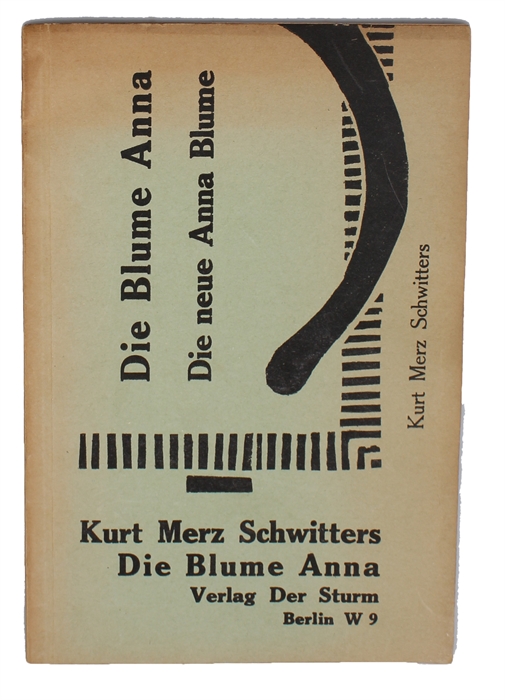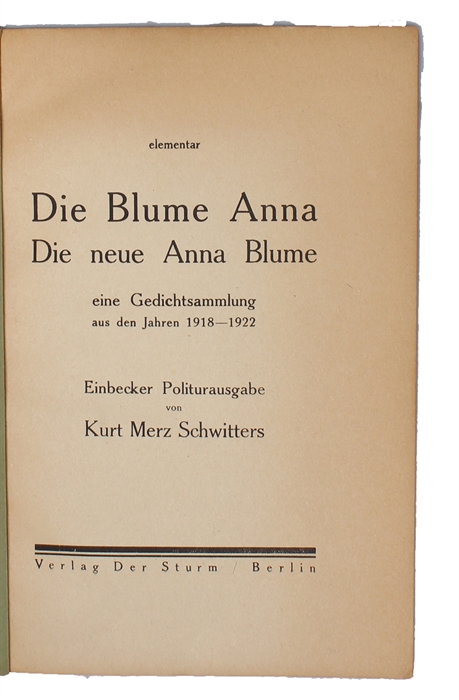THE SYMBOL FOR THE DADAIST MOVEMENT
SCHWITTERS, KURT.
elementar. Die Blume Anna. Die Neue Anna Blume eine Gedichtsammlung aus den Jahren 1918-1922.
Berlin, Verlag Der Sturm, (1923). 8vo. In the original printed wrappers. Light sunning to top of front wrapper. Upper part of spine with a small bump. Ex-libris (Alfred Liede) pasted on to verso of front wrapper. A fine and clean copy. 32 pp.
Rare first printing of one of the earliest edition of Schwitter's famous Dadaist 'sound-poems' (i.e. Dada Klang-Gedichten) often seen interpreted as a parody of a love poem. It famously became the symbol for the Dadaist movement, of the chaos and madness of the roaring 1920ies, and it was seen as the birth of a new poetic language. The poem made Schwitters famous overnight and it was parodied in newspapers and magazines, and strongly polarized public opinion throughout the 1920ies.
Whilst Schwitters was never an official member of Berlin Dada, he was closely linked to many members of the group, in particular Raoul Hausmann and Hans Arp, and the poem is written in a dadaist style, using multiple perspectives, fragments of found text, and absurdist elements to depict the narrator's emotional state in the throes of love, or of Germany's political, military and economic collapse after the First World War.
"Schwitter's developed his own version of Dada, which he called MERZ. Reportedly derived from truncating the name of the German bank Commerzbank, it uses not just ready-mades but also objects that had been thrown away. Merz differed in one crucial aspect from Dada: It was art, not anti-art. Best known are Schwitter's non-sense poems that make sense - just not in the usual sense, in the same way that Schwitters did not restrict himself to the usual five physical senses. His poem [the present] identifies Anna Blume as "the beloved of my twenty-seven senses. The poem takes the reader through an accordingly distorted reality with statements, such as "Blue is the color of your yellow hair, and an equally playful disregard of linguistic rules, while following a grammar of the heart, such as in the poem's last sentence: "Anna Blume, you trickle beast, I love your!". "
"Despite his overtures, however, the Dadaists rejected Schwitters, burning his "Blume" pamphlet at the 1920 Berlin Dada Fair. Too iconoclastic for more conventional artistic movements, Schwitters was too painterly and sentimental for Dadaism. Denied entry by the club he desperately wanted to join, he slapped stickers that said "Anna Blume" wherever he went; he interrupted other artists' talks by barking like a dog. And yet he was as energetic in his artistic activities proper as he was in his provocations, alternating between painting, printmaking, collage, stage design, poetry".
"Given Schwitter's drive towards multivalence, all of these interpretations (An Anna Blume as satire, An Anna Blume as both a critique and subsumption of modernity, An Anna Blume as an expressionistic exposure of the sense surrounding modern experience, and An Anna Blume as a deliberately fashioned alchemical parable) are all possible". (Gamard, Kurt Schwitters Merzbau: The Cathedral of Erotic Misery, P. 57).
Order-nr.: 48967


